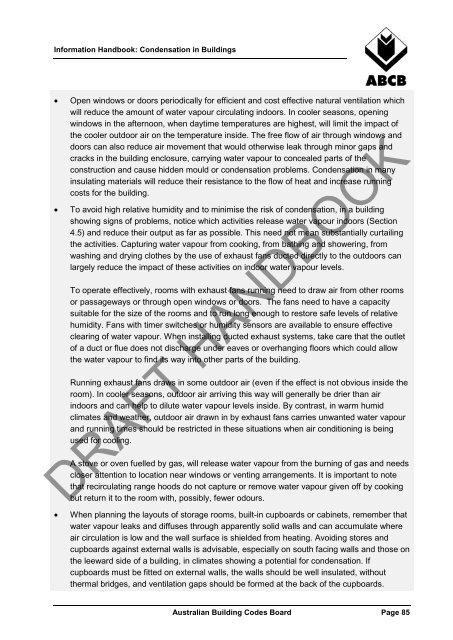Condensation in Buildings - Australian Building Codes Board
Condensation in Buildings - Australian Building Codes Board
Condensation in Buildings - Australian Building Codes Board
Create successful ePaper yourself
Turn your PDF publications into a flip-book with our unique Google optimized e-Paper software.
Information Handbook: <strong>Condensation</strong> <strong>in</strong> Build<strong>in</strong>gs<br />
• Open w<strong>in</strong>dows or doors periodically for efficient and cost effective natural ventilation which<br />
will reduce the amount of water vapour circulat<strong>in</strong>g <strong>in</strong>doors. In cooler seasons, open<strong>in</strong>g<br />
w<strong>in</strong>dows <strong>in</strong> the afternoon, when daytime temperatures are highest, will limit the impact of<br />
the cooler outdoor air on the temperature <strong>in</strong>side. The free flow of air through w<strong>in</strong>dows and<br />
doors can also reduce air movement that would otherwise leak through m<strong>in</strong>or gaps and<br />
cracks <strong>in</strong> the build<strong>in</strong>g enclosure, carry<strong>in</strong>g water vapour to concealed parts of the<br />
construction and cause hidden mould or condensation problems. <strong>Condensation</strong> <strong>in</strong> many<br />
<strong>in</strong>sulat<strong>in</strong>g materials will reduce their resistance to the flow of heat and <strong>in</strong>crease runn<strong>in</strong>g<br />
costs for the build<strong>in</strong>g.<br />
• To avoid high relative humidity and to m<strong>in</strong>imise the risk of condensation, <strong>in</strong> a build<strong>in</strong>g<br />
show<strong>in</strong>g signs of problems, notice which activities release water vapour <strong>in</strong>doors (Section<br />
4.5) and reduce their output as far as possible. This need not mean substantially curtail<strong>in</strong>g<br />
the activities. Captur<strong>in</strong>g water vapour from cook<strong>in</strong>g, from bath<strong>in</strong>g and shower<strong>in</strong>g, from<br />
wash<strong>in</strong>g and dry<strong>in</strong>g clothes by the use of exhaust fans ducted directly to the outdoors can<br />
largely reduce the impact of these activities on <strong>in</strong>door water vapour levels.<br />
To operate effectively, rooms with exhaust fans runn<strong>in</strong>g need to draw air from other rooms<br />
or passageways or through open w<strong>in</strong>dows or doors. The fans need to have a capacity<br />
suitable for the size of the rooms and to run long enough to restore safe levels of relative<br />
humidity. Fans with timer switches or humidity sensors are available to ensure effective<br />
clear<strong>in</strong>g of water vapour. When <strong>in</strong>stall<strong>in</strong>g ducted exhaust systems, take care that the outlet<br />
of a duct or flue does not discharge under eaves or overhang<strong>in</strong>g floors which could allow<br />
the water vapour to f<strong>in</strong>d its way <strong>in</strong>to other parts of the build<strong>in</strong>g.<br />
Runn<strong>in</strong>g exhaust fans draws <strong>in</strong> some outdoor air (even if the effect is not obvious <strong>in</strong>side the<br />
room). In cooler seasons, outdoor air arriv<strong>in</strong>g this way will generally be drier than air<br />
<strong>in</strong>doors and can help to dilute water vapour levels <strong>in</strong>side. By contrast, <strong>in</strong> warm humid<br />
climates and weather, outdoor air drawn <strong>in</strong> by exhaust fans carries unwanted water vapour<br />
and runn<strong>in</strong>g times should be restricted <strong>in</strong> these situations when air condition<strong>in</strong>g is be<strong>in</strong>g<br />
used for cool<strong>in</strong>g.<br />
A stove or oven fuelled by gas, will release water vapour from the burn<strong>in</strong>g of gas and needs<br />
closer attention to location near w<strong>in</strong>dows or vent<strong>in</strong>g arrangements. It is important to note<br />
that recirculat<strong>in</strong>g range hoods do not capture or remove water vapour given off by cook<strong>in</strong>g<br />
but return it to the room with, possibly, fewer odours.<br />
DRAFT HANDBOOK<br />
• When plann<strong>in</strong>g the layouts of storage rooms, built-<strong>in</strong> cupboards or cab<strong>in</strong>ets, remember that<br />
water vapour leaks and diffuses through apparently solid walls and can accumulate where<br />
air circulation is low and the wall surface is shielded from heat<strong>in</strong>g. Avoid<strong>in</strong>g stores and<br />
cupboards aga<strong>in</strong>st external walls is advisable, especially on south fac<strong>in</strong>g walls and those on<br />
the leeward side of a build<strong>in</strong>g, <strong>in</strong> climates show<strong>in</strong>g a potential for condensation. If<br />
cupboards must be fitted on external walls, the walls should be well <strong>in</strong>sulated, without<br />
thermal bridges, and ventilation gaps should be formed at the back of the cupboards.<br />
<strong>Australian</strong> Build<strong>in</strong>g <strong>Codes</strong> <strong>Board</strong> Page 85
















